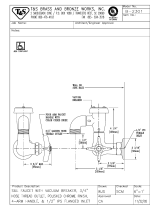
iv
DFM7 - Limited Warranty
LIMITED WARRANTY
Moyer Diebel, (herein referred to as "The Company"), P.O. Box 4149, Winston-Salem, North Carolina 27115, and
Champion-Moyer Diebel P.O. Box 301, 2674 N. Service Road, Jordan Station, Canada, L0R 1S0,
warrants machines, and parts, as set out below.
Warranty of Machines: "The Company" warrants all new machines of its manufacture bearing the name
"The Company" and installed within the United States and Canada to be free from defects in material and workman
ship for a period of one (1) year after the date of installation or fteen (15) months after the date of shipment by
"The Company", whichever occurs rst. [See below for special provisions relating to glasswashers.] The warranty
registration card must be returned to "The Company" within ten (10) days after installation. If warranty card is not
returned to "The Company" within such period, the warranty will expire after one year from the date of shipment.
"The Company" will not assume any responsibility for extra costs for installation in any area where there are
jurisdictional problems with local trades or unions.
If a defect in workmanship or material is found to exist within the warranty period, "The Company", at its election,
will either repair or replace the defective machine or accept return of the machine for full credit; provided;
however, as to glasswashers, "The Company's" obligation with respect to labor associated with any repairs shall end
(a) 120 days after shipment, or (b) 90 days after installation, whichever occurs rst. In the event that "The Company"
elects to repair, the labor and work to be performed in connection with the warranty shall be done during regular
working hours by a "The Company" authorized service technician. Defective parts become the property of The
Company. Use of replacement parts not authorized by "The Company" will relieve "The Company" of all further li-
ability in connection with its warranty. In no event will "The Company's" warranty obligation exceed "The Company's"
charge for the machine. The following are not covered by "The Company's" warranty:
a. Lighting of gas pilots or burners.
b. Cleaning of gas lines.
c. Replacement of fuses or resetting of overload breakers.
d. Adjustment of thermostats.
e. Adjustment of clutches.
f. Opening or closing of utility supply valves or switching of electrical supply current.
g. Cleaning of valves, strainers, screens, nozzles, or spray pipes.
h. Performance of regular maintenance and cleaning as outlined in operator’s .
i. Damages resulting from water conditions, accidents, alterations, improper use, abuse,
tampering, improper installation, or failure to follow maintenance and operation procedures.
j. Wear on Pulper cutter blocks, pulse vanes, and auger brush.
Examples of the defects not covered by warranty include, but are not limited to: (1) Damage to the exterior or
interior nish as a result of the above, (2) Use with utility service other than that designated on the rating plate,
(3) Improper connection to utility service, (4) Inadequate or excessive water pressure, (5) Corrosion from
chemicals dispensed in excess of recommended concentrations, (6) Failure of electrical components due to
connection of chemical dispensing equipment installed by others, (7) Leaks or damage resulting from such
leaks caused by the installer, including those at machine table connections or by connection of chemical
dispensing equipment installed by others, (8) Failure to comply with local building codes, (9) Damage
caused by labor dispute.
Warranty of Parts: "The Company" warrants all new machine parts produced or authorized by "The Company"
to be free from defects in material and workmanship for a period of 90 days from date of invoice. If any defect in
material and workmanship is found to exist within the warranty period "The Company" will replace the defective
part without charge.
DISCLAIMER OF WARRANTIES AND LIMITATIONS OF LIABILITY. MOYER DIEBEL'S WARRANTY IS ONLY
TO THE EXTENT REFLECTED ABOVE. MOYER DIEBEL MAKES NO OTHER WARRANTIES, EXPRESS OR
IMPLIED, INCLUDING, BUT NOT LIMITED, TO ANY WARRANTY OF MERCHANTABILITY, OR FITNESS OF
PURPOSE. MOYER DIEBEL SHALL NOT BE LIABLE FOR INCIDENTAL OR CONSEQUENTIAL DAMAGES.
THE REMEDIES SET OUT ABOVE ARE THE EXCLUSIVE REMEDIES FOR ANY DEFECTS FOUND TO EXIST
IN MOYER DIEBEL GLASSWASHERS AND MOYER DIEBEL PARTS, AND ALL OTHER REMEDIES ARE
EXCLUDED, INCLUDING ANY LIABILITY FOR INCIDENTALS OR CONSEQUENTIAL DAMAGES.
Moyer Diebel does not authorize any other person, including persons who deal in its glasswashing
machines to change this warranty or create any other obligation in connection with its glasswashing Machines.

























